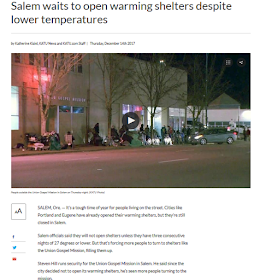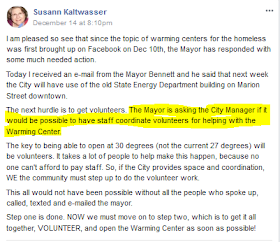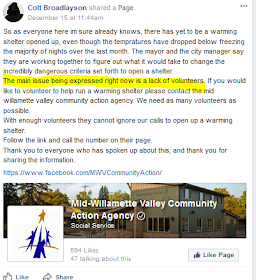By Sarah Owens and Michael Livingston
 |
| Wednesday12/13/17 |
 |
| Saturday 12/16/17 |
The grumbling begins, first on FB. It moves to email (Mayor, City Manager, MWVCAA). Then the Statesman Journal runs a story. Then a local business steps up. Then there's a story about that, and then City officials say they're exploring other options. Then AP and the Oregonian pick up the story about the local business stepping up. Then there's a meeting at City Hall, and...nothing changes, except the critical audience has expanded to the state and the nation. Before the week is out, the warm and fuzzy from The Great American Eclipse is all but forgotten.
Given the planning that made the Eclipse such a success, you'd have thought the City would be able to get out in front of something that happens every winter. Sadly, you'd have been wrong. At our October meeting, Ward 1 Councilor Kaser reported "plans are in place for a warming center", but she didn't go into any detail. MWVCAA was handling it, weren't they?
 |
| Thursday Evening 12/14/17 |
 |
| Sunday 12/10/17 |
"This has been my experience with every program the MWVCAA offers. When I lost my job and was afraid I’d lose my home, I went to the office. There was one woman sitting in a very nice office and no other activity going on. I shared my experience and she handed me a booklet of agencies and that was that. No other personal contact. No other assistance. The booklet had one or two places that might help, but other information was out of date. In fact, every time I’ve called their office, nothing. Their staff is ridiculously uninformed and have no idea how to deal with vulnerable populations."
 |
| Monday 12/11/17 |
 |
| Tuesday 12/12/17 |
 |
| Wednesday 12/13/17 |
 |
| Thursday Evening 12/14/17 |
 |
| Friday Morning 12/15/17 |
Les Margosian replied: "Having volunteered at warming shelters over the last several years, I'm surprised to read that a shortage of volunteers is a major reason for not being able to open. We have not received the customary call for volunteers and I'm thinking that IF this is one of the reasons, its strictly a BS reason. Also, I'm thinking that waiting til Hell freezes over for opening our shelters is probably not a valid criteria." (Emphasis added.) Nevertheless, the "hell freezes over" criteria remained in place following Friday's meeting between City officials and MWVCAA's director, Jon Reeves.
 |
| Friday Afternoon 12/15/17 |
Reeves also told the SJ on Friday that "City officials are 'definitely working on ways to support the effort'." And he didn't want to say what those "ways" might be because, what? We might expect results?
Colt Broadlayson, agreeing with Les, felt like "MWVCAA has been giving us the run around." Susann Kaltwasser said she'd "come to the same conclusion. MWVCAA is not doing a good job on several levels. I think the problems run deep and I am going to urge my elected representatives to start digging into some issues."
 |
| Saturday 12/16/17 |
"When some try to volunteer they are told by MWVCAA that they have enough volunteers and the next training is in January. Something is not right."
Dana Sidhe Seer Canning commented, "MWVCAA in my humble opinion should be removed from the city's go to list period! Churches/ Businesses should be involved and volunteers can staff. Aren't we paying someone $55k to coordinate the homeless [services delivery]? Surely if the city would green light use of a building I would gladly take responsibility to staff and care for our fellow community members."
Yes, the City is paying someone to coordinate homeless services. In fact, they're paying several. In addition to the recently funded Homeless Program Coordinator position at the Council of Governments (which support was a trade off for the County's support of the Mayor's sobering center -- the City's share being $45K, not $55K), there are two Federal Programs staff in the Urban Development Department overseeing the Community Services and Housing Commission which is charged under SRC Chapter 20G to execute certain duties, including "Initiat[ing] efforts toward exchanging information for the purpose of coordinating social service delivery systems, public and private, and their governing and administrative bodies that affect the Salem area population." There's also the Salem Housing Authority that staff the Emergency Housing Network and coordinate all the service providers needed to run their Housing Rental Assistance Program (HRAP).
 |
| Monday 12/18/18 |
Will the community retain in 2018 what it has learned in 2017? Or will they/we and the City again rely on MWVCAA for warming center planning? Because, if we do rely on MWVCAA, it's Groundhog Day.
Golf, anyone?
 |
| Monday 12/18/17 |
Update 12/18/17: MWVCAA determined that their forecast criteria had been met, and activated a warming shelter in the central area for the period Wednesday 12/20/17 thru Tuesday 12/26/17. (First Presbyterian Church (Chemeketa and Winter.) They say they require 32 volunteers/staff per four hour shift. Professionals we talked to think experienced shelter operators probably would not require as many volunteers.
Update 12/27/17: The requisite number of volunteers signed up, and MWVCAA stayed open through 6:30a Tuesday, despite the thermometer and forecasts rising a few degrees above 27. Lows over the New Year's Day weekend are expected to hover around freezing, rising to mid thirties later in the week. For more about the 2017-2018 sheltering season, see "MWVCAA's Cold Weather Shelter 2017-2018."

















